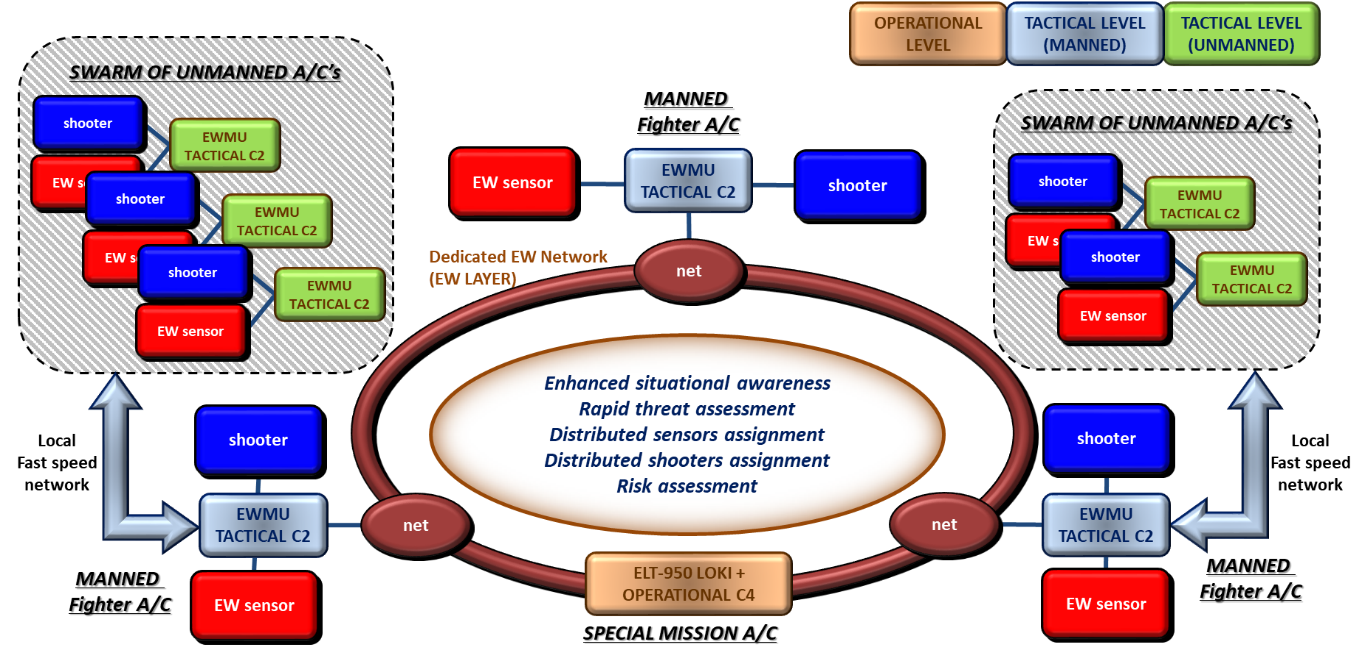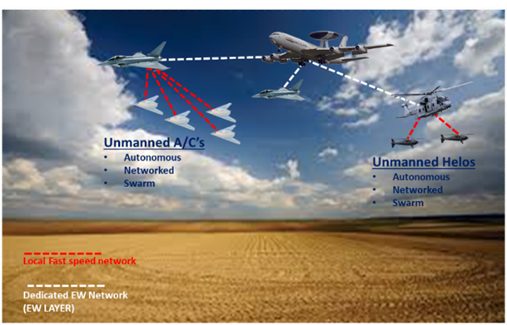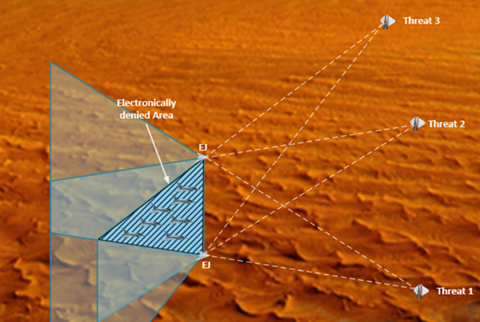Collaborative EW
Collaborative EA encompasses trends and advancements focused at generating broader EA effects at the operational level, which includes the optimal allocation of limited EA assets over a longer duration and broader geographic areas than EA support to single target area and short time on target.
Therefore, Collaborative EW implies a multiple layer collaboration: Stand-Off/Stand-In collaboration, Sensor collaboration, Man-Machine Collaboration, Manned-Unmanned Teaming, blue on blue collaboration/interoperability.
A big impact to Collaborative EW will be given by the envisaged proliferation of unmanned platforms. Applying collaborative EW and SIGINT functions in such cases means:
-
Subdivide the whole function in sub-functions that could be realized in small payloads
-
Be able to coordinate the platforms in a way to reconstruct the whole from its components
-
Count on a communication infrastructure which has to be solid, trusted and capable to manage synchronization of data gathered using different platforms
-
Plan the mission according to platform endurance
Operational implications refer to:
-
Command and Control and Decision Making Process
-
Mission planning for distributed tasks
-
Reconfiguration during mission
-
Multi-domain distribution (time-frequency-space) of sensors and effectors
-
Cyber resilience
A significant case study will be discussed: it refers to how a traditional Stand-Off EA capability can benefit by a collaborative approach among manned and unmanned platforms.
Advantages in terms of operational performance, effectiveness, human risks and costs will be shown. Therefore, it will be easy to imagine how the feasibility of peculiar missions is possible in a Collaborative configuration only.
EMSO Network-Centric approach: all for one and one for all
Battlespace Awareness requires enhanced information content, advanced means to rapidly sense, collect, process, analyse, evaluate and exploit intelligence regarding adversaries and the operational environment.
EW assets, beyond their all-time role of passive intelligence and active protection, have evolved since several years becoming important elements of C4ISTAR systems and system of systems.
The role of EW is therefore no more limited to the protection of the single platform or several platform but to control, manage and protect our use of the EMS in order to maintain essential network and data link services across secured segments of the EMS to transport, share, store, protect and disseminate critical information.
Adversary use of the EMS must be known, controlled and denied in order to stop and/or to degrade the correct flow of information, to delay or to impede the adversary decision-making process.
In the future and in response to the new role of EW assets, net-centric based operations are needed to ensure the coordination of assets, expertise, knowledge and tools in order to integrate EW systems in the platform and across the cooperating platforms to the Decision Makers.
Modern EW operations suggest the definition of an EW layer in which the Information Management Organization collapses into a Command & Control Information structure.
This is not only a high-level change but also a technological challenge for all the Countries and Industries involved in the field.
To this respect the network is the force multiplier and the future objective is collaborative “knowledge sharing”.
Each mission element or platform is a node operated as part of a unified whole that allows aggregated as well as distributed operations.
In this way, any individual system installed on a single platform can be integrated with electronic systems on the same platform and on other platforms to create a SYSTEM OF SYSTEMS in which each platform contributes to the mission and to the protection of the others:
ALL FOR ONE AND ONE FOR ALL.
The network is the basis of an information infrastructure that allows for centralized interpretation and operational control and distributed situation awareness to all platforms.
Information content is the fuel that makes the decision process run, enabling armed forces to more effectively manoeuvre and coordinate actions that target and engage opponent forces.
The boost of unmanned platform and the MUT
A new era is opening when small-unmanned aerial are put into action as electronic warfare actors to enable operations on the forward edge of the battlefield, from proximity Intelligence-Surveillance-Reconnaissance up to active countermeasures towards radars, communications, and other RF systems.
A modular and flexible architecture can meet emerging needs and support open interfaces to enable integration and interoperability into a really modular and high-performance EMSO solution, for Radar and Communications Surveillance-Reconnaissance and Electronic Attack.
In a network-centric approach, this enables the capability of UAVs and/or USVs to conduct electronic warfare missions in concert with other manned and/or unmanned aircrafts and/or surface systems in a multi-node approach against even more capable integrated air and naval defence systems.

Figure 1: Manned Un-manned teaming and the network
Data/information sharing among platforms is therefore beneficial for many operations as it allows new functions, such as:
-
Improvement in Situation Awareness improvement by real time cooperative data sharing
-
Multi-platform Instantaneous Geolocation and passive (covert) Targeting
-
Co-ordination & Synchronization of Squadron defence/attack operations, throughout Coordinated Jamming Techniques
-
Assignment of inhibited/allowed sectors to each platform in real time
Beyond those sentences, the latest buzzword in the community today is MUT (Manned-Unmanned Teaming), the win-win situation in the combat domain where the intellect, grit, instant decision-making capability and the hunch of a combat pilot are being combined with the precision, endurance and all-weather and all-terrain capability of the unmanned machine.
The capability to put in network EW Systems on-board different platforms, including unmanned platforms, opens the possibility to connect in real time Special Mission platforms (playing diverse role such as Patrol, Escort, ELINT) to a mission package composed by manned and unmanned vehicles equipped with EW payloads.

Figure 2: Manned Un-manned teaming deployment
Unmanned platforms are included in the extended EW layer of integration, being part of the EW network coordinated by Stand-Off Command & Control platform (i.e. a Special Mission Aircraft), to play the equivalent role of fighter aircraft wingman (for Escort mission) or deep intruder (for Stand-In mission).
In the following, when equipped with Offensive Electronic Attack capabilities, aerial unmanned platforms will be referred as UCAV (C for “Combat”) as they are electronically “weaponized”.
The network-centric operation enables coordinated missions of multiple platforms against multiple threats with pre-programmed instructions.
The opportunity to give the system of systems a certain degree of autonomy in the decision-making process will open scenarios never imagined before.
When installed on-board the unmanned platforms, this will enable autonomous operations to independently acquire, track and target threats without the presence of a-priori precise intelligence data and/or optimize the policy of countermeasures in executing tasks of electronic attack.
Some relevant examples:
Unmanned vehicles with jamming capabilities, deployed under the leadership of a manned C2 aircraft, can operate in a Manned-Unmanned-Teaming (MUT) to create an electronically denied area.
Given their intrinsic multi domain stealthness, the UCAVs can operate closer to the threats than manned platforms with similar role, gaining an advantage in terms of time and power.
In case of search radars, this will give the possibility to create false targets closer to the threat also in case of RF agile radars.
In case of tracking radar this will prevent the range gate to catch the intruders echo because one or more closer credible targets (coherent) are created, with a cheaper amount of power required.

The UCAV can perform all the missions of an Escort platform.

Figure 4: Deception in Stand-in Jamming
The additional advantage is that, being possible to get closer with respect to the defended platform to the victim radar, also in case of RF agile radars the countermeasure can be coherent on a pulse-by-pulse basis.
In fact, the radar wave front will hit the UCAV well before the defended platform (the UCAV will not produce a significant echo because its small dimensions) and this range advantage will give time to the UCAV based jammer to reply with coherent pulses positioned in front with respect to the platform echo, performing a real range gate pull-in.
In all the above situations, the coordination of the mission is actuated by a Stand-Off (manned) platform, according to the planning.
Essential for the correct execution and the success of the mission are:
-
the availability of a dedicated connectivity infrastructure
-
a Command and Control of Electronic Warfare, integrated in the upwards C4I

Figure 5: Concept of Operation for Offensive Electronic Attack in Stand-in missions
Command and Control of Electronic Warfare: a must-have
Electromagnetic Spectrum Operations (EMSO) demand a level of coordination and synchronization which is impossible without specialized capabilities that support situational awareness, coordination and priority of action in the electromagnetic environment (EME).
Commanders are tasked to attain the level of superiority required to enable effective friendly forces’ use the Electromagnetic Environment while simultaneously exploiting, preventing or reducing the adversary forces’ EME usage.
NATO doctrine recognizes that NATO operations are complicated by an increasingly congested and contested EME.
All modern forces conduct operations that depend on the use of the EME.
The recognized need for military forces to have access to and utilize the EME creates vulnerabilities and opportunities for EW.
Today’s communication, sensing and guidance devices, whose function depends upon electromagnetic energy, are increasingly used both alone and in networked arrangements by civilian and military organizations.
Therefore, Command and Control of Electronic Warfare (EWC2/C4) is growing as an emerging need, including development and implementation activities associated with the supporting functional services (Mission simulation, Mission support, Training).
Command and Control of Electronic Warfare (EWC2) describes the development and implementation activities associated with the supporting functional services for planning, coordinating and managing EW activities focused on mission execution, whatever the mission.
EW Command & Control EWC2
Electronic Protection Concept
Electronic Attack Aka Electromagnetic Attack
Electronic Support Aka Electromagnetic Support
Cognitive EW
Net Centric EW
Agnostic EW
Operational Support in EW
Validation in EW
Simulation in EW
Navigation Warfare
Space EW







